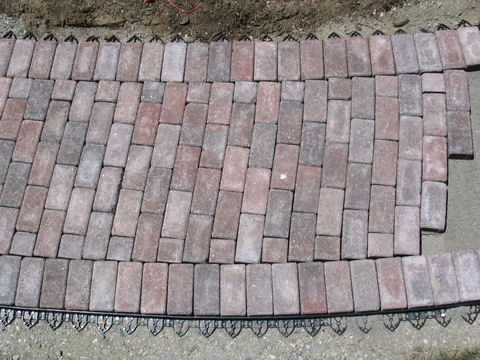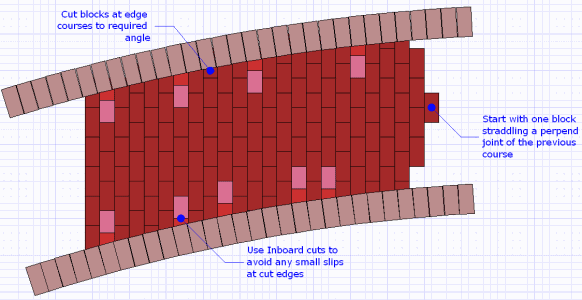Hello:
I’m doing a walkway with a transverse stretcher bond, and the edging course joints staggered from the body of the walk. As you can see from the pictures as I’ve started to travel around a curve in my walkway the gaps between the edging course and the outside course of the stretcher bond have become excessive. The body of the stretcher bond has also started to shift from perpendicular to the walk to diagonal to the walk.
Can you help me resolve this problem? I’m thinking that I need to taper the edging course, or trim the outside edge of the stretcher bond (the half blocks only) at an angle to compensate for the gaps created by the curve, or a combination of both. If so, is there a way to calculate the angles for the taper &/or stretcher bond cuts?
Thanks for your help.
picture
Transverse stretcher bond around curves - How to resolve gaps and pattern shift
-
Paverman Dan
- Posts: 70
- Joined: Tue Jun 29, 2004 5:27 am
Is it possible to "cheat" your joints between the field pavers a bit to straighten them out so they are more perpendicular to the border at the curve?
I'm looking at 18 rows of pavers in your photo; and no more than 1"-2" total that would need to be cheated over.
All this would mean is that you have to extend your joints near the border on the lower half of the photo an extra 1/18" (lets see, in metric . . . ah, forget it, I'll let you Euros figure that one!) , then taper off each joint to it's regular width -1/16"-1/8" in ICPIland--as you go to the top of the photo. I think 1/18", and with that curve mathematics and geometry would determine its going to be more closer to a 1/8" addition on each joint . . . . . would be hardly noticable.
Tony, am I off my rocker here?
I'm looking at 18 rows of pavers in your photo; and no more than 1"-2" total that would need to be cheated over.
All this would mean is that you have to extend your joints near the border on the lower half of the photo an extra 1/18" (lets see, in metric . . . ah, forget it, I'll let you Euros figure that one!) , then taper off each joint to it's regular width -1/16"-1/8" in ICPIland--as you go to the top of the photo. I think 1/18", and with that curve mathematics and geometry would determine its going to be more closer to a 1/8" addition on each joint . . . . . would be hardly noticable.
Tony, am I off my rocker here?
-
Tony McC
- Site Admin
- Posts: 8346
- Joined: Mon Jul 05, 2004 7:27 pm
- Location: Warrington, People's Republic of South Lancashire
- Contact:
Bloody fractions - how the hell can you work with such ridiculous figures? One-eighteenth??
I think the idea you have, Dan, is basically sound. The transverse courses need to be parallel and 'square' to the edge courses. However, if this is one of those paths that wanders around a bit while the field (or body) blocks maintain their orientation, then it's imperative that they are kept parallel, and regular checks back to a base line will be needed to prevent any 'drift' off course.

So: those tranverse courses should be set out relative to the preceding course, ensuring a half-block offset. Then, when it comes to the blocks meeting the edge course, those should be cut to suit, ensuring that the cut edge is parallel to the edge course, not square to the block itself, or the transverse course. Looking at the picture I've re-posted above, it seems that Herm doesn't realise pavers can be cut at an angle: each cut is a half and has been cut square, if you know what I mean.
Herm - don't worry too much about commencing each course with a half-block. Start away from the edge course and set a paver in position so that it straddles one joint of the preceding course, then lay blocks to either side of that "starter block" until you get to the edge course, when you;ll need to cut blocks to suit. Some of these cuts might be three-quarters of a block, some will be quite small, but use Inboard Cuts to avoid any pieces less than a quarter of a block.

I think the idea you have, Dan, is basically sound. The transverse courses need to be parallel and 'square' to the edge courses. However, if this is one of those paths that wanders around a bit while the field (or body) blocks maintain their orientation, then it's imperative that they are kept parallel, and regular checks back to a base line will be needed to prevent any 'drift' off course.

So: those tranverse courses should be set out relative to the preceding course, ensuring a half-block offset. Then, when it comes to the blocks meeting the edge course, those should be cut to suit, ensuring that the cut edge is parallel to the edge course, not square to the block itself, or the transverse course. Looking at the picture I've re-posted above, it seems that Herm doesn't realise pavers can be cut at an angle: each cut is a half and has been cut square, if you know what I mean.
Herm - don't worry too much about commencing each course with a half-block. Start away from the edge course and set a paver in position so that it straddles one joint of the preceding course, then lay blocks to either side of that "starter block" until you get to the edge course, when you;ll need to cut blocks to suit. Some of these cuts might be three-quarters of a block, some will be quite small, but use Inboard Cuts to avoid any pieces less than a quarter of a block.

Site Agent - Pavingexpert